The process of marketing is how a company or organization goes about reaching out to its target audience. Prior to the introduction of the 8th P, marketing mix was defined by the 4Ps, and then 7Ps. A company can achieve good visibility, in-demand products, competitive pricing and effective marketing when all these marketing Ps are thoughtfully & strategically integrated into a marketing mix.
Advertising and marketing is not a new thing and definitely not for the digital age only. It has always been there for the early traders to the modern entrepreneurs. You can even say that marketing is as old as human civilization itself. Word of mouth was the first-ever marketing strategy that worked for centuries, only to be joined by the written and distributed forms of marketing of the modern age.
Take a look below to understand how different forms of marketing have evolved over the years:
| 2300 B.CE – Clay Pots | 1973 – Cellphones |
| 1440 – Printing Press | 1977 – Computers |
| 1741 – American Magazines | 1998 – Google |
| 1830S – Telegraph | 2004 – Facebook |
| 1839 – Posters | 2006 – Twitter |
| 1900 – Radio | 2007 – iPhones |
| 1920 – TV | 2010 – Instagram |
You will be astonished to know that in ancient Babylonia (presently Iraq), artists were appointed to paint pictures of honorable people and prominent families on clay pots to promote them in public. They also painted key updates regarding political scenarios and changes to be brought about to inform the people, as there were no newspapers during that time. You can refer to it as one of the earliest forms of marketing strategy.
It was only after the Second World War that a proper marketing mix was developed.
Understanding the elements of marketing mix with examples
The 4Ps of marketing are essentially the basics of any marketing mix. Over the years, marketing professionals have improvised the Ps and added more to the mix, but they could never remove a P from it. Every other mix that we may come across has its origins in these marketing 4 Ps, without which we cannot understand a thing. Now, you must be wondering what a marketing mix is. Let’s cut the long story short.
A marketing mix is a series of good factors that help the customers get attracted to a brand and end up buying their products/services. The marketing executive’s job is to work out the best mix to increase the chances of selling. This mix refers to the 4Ps to enhance the brand image and influence buying decisions. Sometimes, three more P’s are added to the mix according to changing customer types, preferences, demographics, etc.
In the digitized world of today, nothing goes ahead without the right marketing mix behind it. Your brand may not even reach your target audience if you do not market it properly. However, the concept of marketing 4Ps is quite old, the term being coined by Neil Borden, a professor of advertising at the Harvard Business School in 1950. However, it was not before McCarthy introduced it in his book, “Basic Marketing” in 1960 that advertisers and marketers took to the idea.
In the simplest terms, the 4Ps of marketing are the ingredients to make your brand stand out from others by identifying and promoting its USP (Unique Selling Points). Before we get to the details of the 4Ps in marketing, let us break them down to understand better.
Introduction to the 4Ps of marketing mix
| PRODUCT | PRICE | PROMOTION | PLACE |
| Quality Design Branding Features Packaging Services Functionality Technology Availability Convenience | Strategy List Price Premium Discounts Credit Terms Payment Methods Allowances Payment Period | Advertising Sales Public Relations Social Media Sponsorship Influencers Product Placement Content Marketing SEO Mobile Marketing Apps | Channels Coverage Transportation Location Logistics Trade Fairs Inventory eCommerce |
The four Ps of marketing essentially stand for Product, Price, Promotion, and Place. To explain, the marketing mix is all about the right product put at the best price point at the right place through effective promotion.
The First P – Product!
We do say ‘product’, but the term also stands for any kind of service, ranging from pet food to plumbing and electrical. It is broadly classified as anything you offer the customer. In any marketing strategy, the primary focus is improving the quality of the product you are offering to the customers. What makes it unique? How can customers benefit from it? How is it any better than those of your competitors? All these queries need to be resolved before you start working on the other Ps.
Now, how to determine a product’s quality. Experts feel that it encompasses several factors, like:
- How fit the product is for use
- Its ability to meet customers’ needs
- Convenience in terms of customer experience
- Freedom from defects
- Compliance with the expected standards
- Value for investment
It may also include other determinants depending on the type of product, as shown mentioned below:
| Facility | Documentation on Records |
| Equipments | Complaints & Recall |
| Storage & Distribution | Laboratory Control |
| Materials Management | Rejection and Refuse |
| Production & Process | Change Control |
| Packaging & Labelling | Organization |
| Validation | Personnel |
Once you have the product ready, you should decide on the best price point for the same, which takes us to the next P of a marketing mix, i.e. price.
The Second P – Price
You should decide on the best price point at which the product will be available to the customers. And trust us, it is not an easy job. First of all, you should understand how much the product is worth by running thorough research of the market. Next, you should get an idea about the prices of similar products offered by your competitors. Thirdly, you can run a quick survey to know how much the customers are willing or are comfortable to pay for the product. Last but not least, you should also think about what kind of discounts you can offer on your products.
One more thing that marketers focus on is the language used to describe pricing. A lot depends on that. Take the following example. Go through it once and analyze your first impression regarding the pricing:
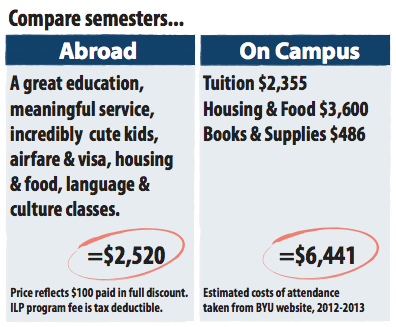
You get the idea, right? Now, let’s move over to the third P of marketing in the marketing 4Ps, i.e., Promotion.
The Third P – Promotion
After understanding the pricing specifics, you should think of ways to promote the product. That being said, know that promotion can make or break your brand, so you have to be careful. The advantage of using a professional marketing team is leveraging their knowledge and experience in the field to get the best launch and promotion for your product. They will be aware of all the latest marketing insights, as well as your competitors’ activities, to develop the best promotional strategies. Apart from that, they will also help you create a brand message, enhance brand awareness and increase its visibility among the target audience.
In the digitally-dominated world of today, online promotion is equally important as offline advertisements. To garner the benefits of the same, you need to establish your brand on all the prominent social media platforms, like Facebook, Instagram, YouTube, Twitter, and LinkedIn – the more, the better. Almost 90% of marketers believe that their activities on social media have helped increase brand exposure. When it comes to local businesses, about 44% depend on social media marketing strategies to increase brand awareness, while 41% do so for revenue. Again, 41% of marketers affirm that 10-25% of online traffic is generated through social media campaigns. Hence, no matter what other forms of promotional strategies you are using, social media should be a priority.
Check out the following image to understand further the importance of social media in promotional endeavors.
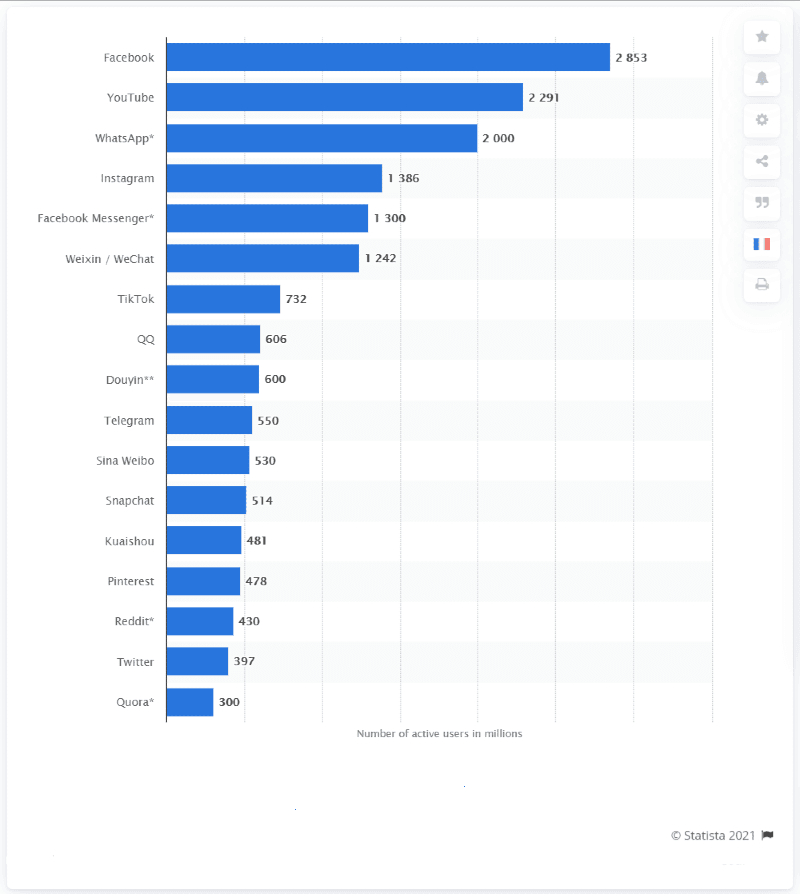
Must Read: The 10 best free tools to manage your social media marketing
Besides launching promotional campaigns for your products, you should also go the extra mile to track the progress or failure of the campaigns. You can get several tools on the internet, both free and paid, for the same. These tools will help you track the key metrics, like website visits, bounce rate, click-through rate, and others to evaluate the performance of each campaign. Refer to the images below:
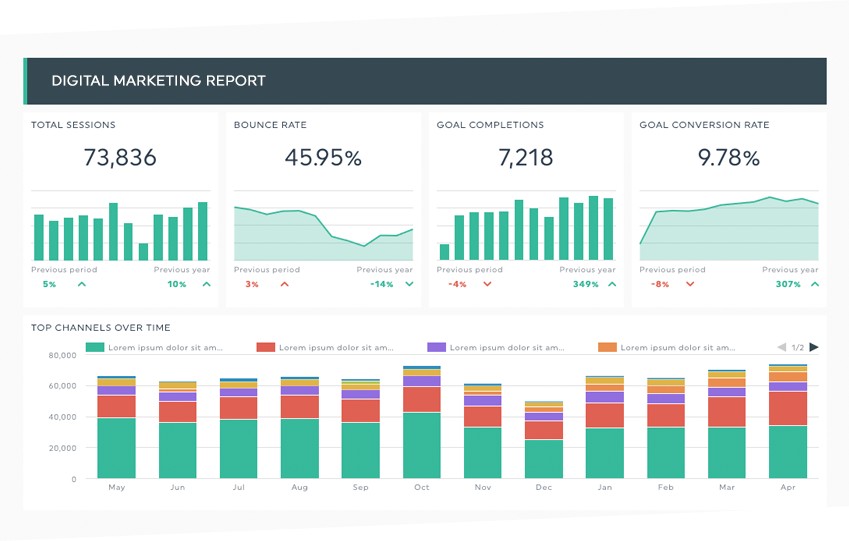
This is a thorough digital marketing report that shows the bounce rate, goal completions, and conversion rate with respect to the total number of sessions in a marketing campaign. As you can see, it gives you a monthly analysis of how well the campaign is performing, as well as compares it to the previous year’s performance.
Check out the next one:
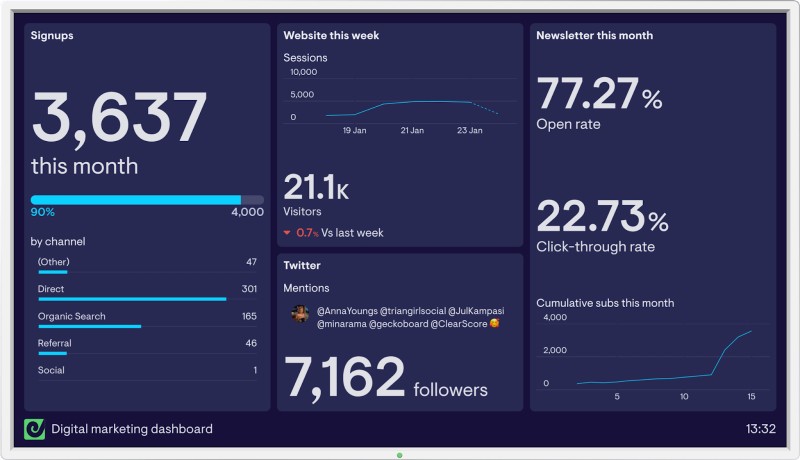
This is yet another marketing dashboard example that gives you a concrete yet simple idea about the campaign’s performance by revealing key metrics, like the number of visitors and subscribers (sign-ups) on the website, followers on social media, and open rate and click-through rate for email newsletters. It is essential to keep a track of all these data to identify loopholes in your marketing campaigns and reduce the same. It also gives you an idea of what promotional strategy works best for your product.
The Fourth P – Place
Place, or location to be precise, is the fourth P in the marketing mix. You have to choose the right location for marketing your product, depending on your target customers. Didn’t get it? Well, here’s an example. Say you wish to provide hair care services in NYC. Depending on the type of customers, you should do research on where they are the most available, online and offline, and market your services accordingly. It is unwise to expect your customers to find you. Instead, you should be where they already are.
When you are marketing your brand online, it may seem that the location is not necessary, but it is. You cannot target the entire world for your brand to get recognition. Target locally at first, only then can you achieve the desired results. Then again, you have to be platform-specific. If your target customers are mostly available on Instagram, your marketing strategies should be directed towards that platform. Promoting the product on Twitter or TikTok won’t help much. Before choosing the right location for promoting your brand or any specific product, you should ask the following questions to yourself:
- Where are your potential customers found the most?
- What are the distribution channels for our product?
- Does your brand have a B2B or B2C approach?
- What is the target location of your competitors?
Once you are prepared with all the answers, you will get an idea to choose the best location to market your business.
Now that you have a theoretical idea about the 4Ps of marketing, your focus should be to find out how to use them to sell.
How to use the marketing 4Ps to sell?
To successfully sell a product, each element of the 4 Ps of marketing need to be incorporated into the complete mix. You should also be aware of all the Ps with respect to your business specifics. Each product is different from the other, which requires you to get an in-depth understanding of yours.
Hence, developing an effective marketing mix should take place in the following steps:
Step 1: Choose a product
The primary step should always be choosing the product you wish to sell first. If there are multiple products, you have to generate a marketing mix for each.
Step 2: Understand the product’s value
Know why your product should sell. In other words, you should identify the unique selling point of your product and analyze it thoroughly. Also, know the quality and characteristic features of products that your competitors are selling and compare those with yours. What makes your product unique? What feature of your product will attract your customers the most? Take notes and highlight those features in your marketing campaign.
Step 3: Identify your customers’ needs
What do your customers seek the most? How well does your product meet those needs? These are the questions that you should ask yourself in this step. You should make all the necessary changes to help your product cater to the customers’ requirements and preferences before launching it. otherwise, the entire thing can be a waste of time and resources.
There are several ways to understand what your customers seek, but the most effective one is communication. Open channels for interacting with your customers regularly to get an idea of their preferences. Digitally, you may hold surveys, conduct polls, or even come live to answer your customers’ questions and analyze the data obtained to get an idea about their expectations.
Live streaming has reached its peak of popularity in recent days. Both brands and individual influencers are leveraging social media live sessions to interact with their target audience and generate data. In fact, about 80% of potential customers these days prefer live sessions over blog posts to buy a particular product. You can either come on live or hire an influencer to promote your product through live interactions.
Step 4: Evaluate your product as per customers’ needs
Once you are aware of your customers’ needs, your focus should be on evaluating the product you have chosen based on that data. If there’s anything missing, work on it so that the product successfully meets every requirement and preference of the customers. You may also use this information to promote your product on different channels later. Highlight the features that cater to your customers’ requirements to attract them faster.
Step 5: Locate your customers
This step correlates with the fourth P in the 4Ps of marketing, i.e., Place. You should know the places of high occurrence for your customers, both online and offline, and target them there. Also, know the time of their availability to schedule your promotional strategies accordingly.
Step 6: Decide the pricing for the product
The second P in the marketing mix is Price, as you already know by now. But deciding the right price for your product can be tricky. With proper evaluation, you should set a price range that both benefits you and your customers. Talk to the marketing executives to obtain data on customers’ expectations for prices, as well as the pricing for competitors’ products. You should learn more about the spending habits of your customers and match it with the category of your product – whether it falls in their regular priorities or secondary needs. If you want your product to seem exclusive, you can increase the price a little. However, make sure that the quality matches the raised price.
Step 7: Generate marketing messages
Coming to the promotional aspect of the product, you should generate eye-catching, crisp and comprehensive marketing messages for your target customers. These messages should describe the USP of the product, its value and inherent benefits. You should communicate this message through different marketing channels to reach your target audience. Different types of marketing strategies will need separate messages, be it traditional or digital promotion.
Step 8: Evaluate the marketing mix (Entering three more Ps making it 7Ps)
Once you have everything ready, you should consider each P in the 4Ps of marketing and see if they work holistically in favor of your brand. In a successful marketing mix, each P world in coherence with the others, so that there is no loophole. If required, you can add other Ps, namely, People, Process, and Physical Evidence.
- People (The Fifth P) – P for people essentially denotes the experience you provide your customers with. You can hire a team of seasoned experts to explain the product and its specifics, as well as clarify doubts regarding it. These professionals generally make up the technical support teams that offer their extensive services regarding your product.
- Process (The Sixth P) – The process of making the product available to your customers should be reliable and fast. In this age and time, people are also more inclined towards sustainable logistics that should be considered if you wish to create a seamless process of delivery.
- Physical Evidence (The Seventh P) – This P is applicable for the modern customers who like to count everything about a product, including its look, feel and smell, if any. Hence, care should be taken to enhance the appearance of the product, its packaging and presentation. However, this P is irrelevant if your product consists of a service.
Still have doubts? You can understand the 7Ps of marketing better from the image below.
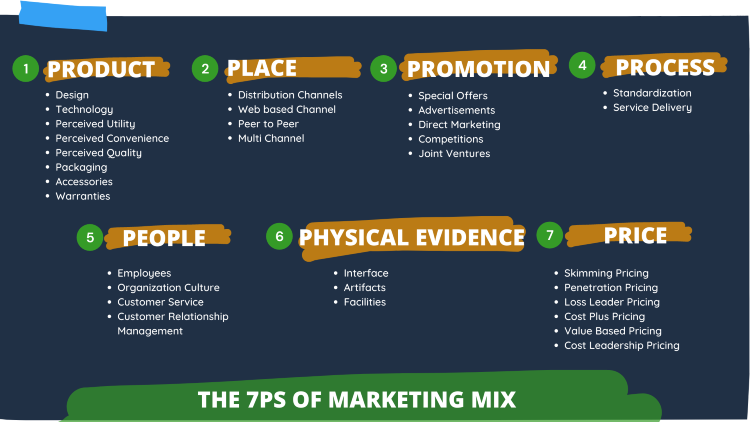
Here comes the 8th P of marketing. The above 7 P’s of marketing are not complete without this 8th P!
The 8th P of marketing mix aka partnership, has recently emerged in marketing theories. A partnership is nothing more than a collaboration between brands. Through partnerships, brands can tap into a wider market and provide services at a bigger scale. For example, we can take the partnerships between Kanye and Adidas, BMW and Louis Vuitton, Starbucks and Spotify, Uber and Spotify, Amazon and AMEX etc.
In the recent world of marketing, this newly introduced 8th P is one of the key features of marketing mix. The 8th P is the partnership that takes place between the already established companies with newer companies. The partnership can also take place between different entities that are present in society. The partnership is one of the steps that is being taken to bring about more success to the established brands along with bringing awareness about a new brand.
8th P (Partnership) has a lot of benefits:
- It gives out recognition to the newly formed brand;
- It gives the new brand a better platform for further growth;
- Partnerships also enable established brands to grow;
- Together, both companies can reach a larger audience;
- Nevertheless, the brands retain their identity.
Brands would be able to work on each other’s shortcomings as well as strengths through collaboration. As a result, all the brands entering into partnerships will grow.
Your burning questions about the marketing mix (4ps, 7ps & 8th p), answered
What are some challenges of implementing the 4Ps of marketing?
Incorporating the 4Ps in any marketing model is not cake walk. Some of the challenges that marketers and business owners face are categorizing the products, especially when services. It is not explicitly mentioned how to implement the 4Ps in service-related products. Then again, the 4Ps mostly focus on the seller’s perspective and not the buyer’s, which results in missing points or loopholes. One can even end up developing a product that does not meet the customers’ requirements.
The only way to overcome this challenge is to evaluate each P in the marketing mix with respect to the buyer’s interest and benefits along with the sellers’. Proper categorization of products is also essential. One should also cross check each P before incorporating it into the marketing mix.
What are the 4Cs of marketing? Is it similar to the 4Ps?
Well, the 4Cs are nothing but a changed perspective of the 4Ps. Instead of Product, Price, Promotion, and Place, they denote Customer solutions, Customer costs, Communication and Convenience respectively.
Is the marketing mix another term for a marketing strategy?
Although the terms are relatable, there are some fundamental differences. While marketing mix is focused more on understanding the product, its value and promotional scope, marketing strategy is more about how to sell the product faster.
Is the marketing mix fixed or can it be changed?
The marketing mix is flexible. Depending on the type of products, their value, pricing and scope for promotion, the 4Ps of marketing can be altered effectively. Which variable to focus on will depend on a lot of factors that an experienced marketer can tell you all about. One of these factors is the changing preferences of the customers that decides how to develop the marketing mix for any product.
Can the marketing executive help in developing the mix?
A marketing executive or manager has in-depth knowledge and extensive experience to treat each variable in the best way possible. S/he can create the right mix for your product to achieve the desirable results. From developing the mix to altering the variables according to the changing requirements of both customers and sellers, an efficient marketing manager can handle all tasks seamlessly.
Wrapping it up
Too much information can be difficult to digest. As it is, the marketing mix is not some fixed plan that you can execute blindly to achieve your goals. The concept should be understood and memorized by heart to implement successfully.
Hence, we have decided to sum up the key points for you.
The 4Ps of marketing are:
- Product – What you are selling or planning to sell
- Price – The desired value of the product
- Promotion – How to promote the product
- Place – Where to promote the product (Where the customers are available the most)
8 Steps to implement the marketing mix:
- Choose the product
- Understand its value for the customers
- Identify customers’ needs
- Evaluate the product based on those needs
- Locate the customers
- Decide on the pricing
- Develop marketing messages
- Evaluate the mix (7ps of marketing)
The 4Ps of marketing are the fundamentals and typically make the marketing mix. Over the years, marketing experts have improvised the Ps, making it 7Ps, and then included 8th P. All of these elements influence each other to form the set of actions, or strategy, that a company uses to promote its brand or product or service in the market.
While the marketing mix has already been amended to 8th P, increasingly it includes several other Ps like Positioning (9th P) , Packaging (10th P) , Politics (11th P) making it 11Ps of marketing already.
Would you like to add any other Ps of marketing mix?